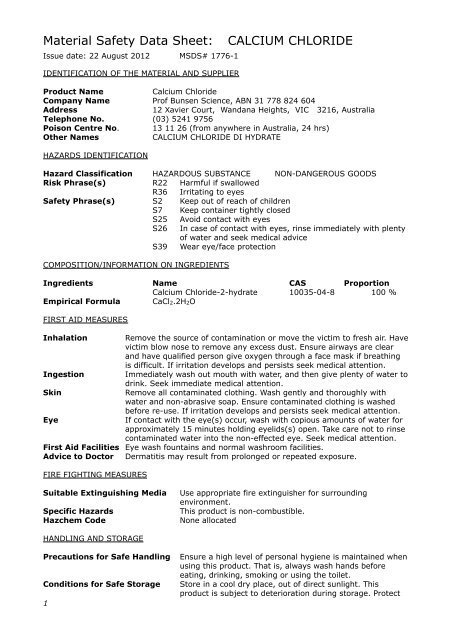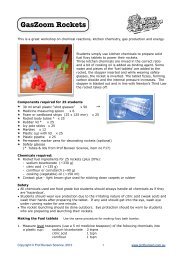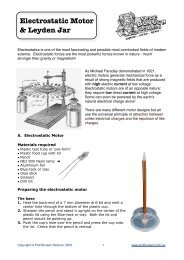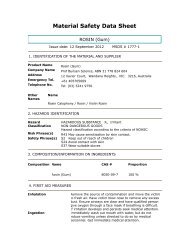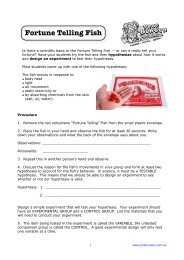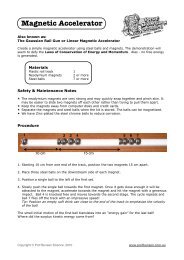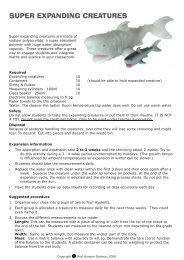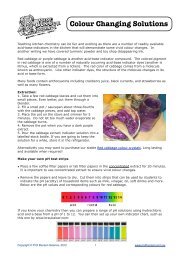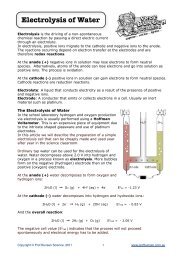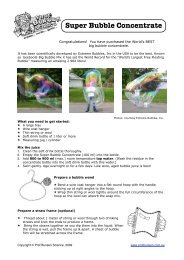Material Safety Data Sheet: CALCIUM CHLORIDE - Prof Bunsen
Material Safety Data Sheet: CALCIUM CHLORIDE - Prof Bunsen
Material Safety Data Sheet: CALCIUM CHLORIDE - Prof Bunsen
You also want an ePaper? Increase the reach of your titles
YUMPU automatically turns print PDFs into web optimized ePapers that Google loves.
<strong>Material</strong> <strong>Safety</strong> <strong>Data</strong> <strong>Sheet</strong>:<br />
Issue date: 22 August 2012 MSDS# 1776-1<br />
IDENTIFICATION OF THE MATERIAL AND SUPPLIER<br />
<strong>CALCIUM</strong> <strong>CHLORIDE</strong><br />
Product Name<br />
Calcium Chloride<br />
Company Name <strong>Prof</strong> <strong>Bunsen</strong> Science, ABN 31 778 824 604<br />
Address<br />
12 Xavier Court, Wandana Heights, VIC 3216, Australia<br />
Telephone No. (03) 5241 9756<br />
Poison Centre No. 13 11 26 (from anywhere in Australia, 24 hrs)<br />
Other Names<br />
<strong>CALCIUM</strong> <strong>CHLORIDE</strong> DI HYDRATE<br />
HAZARDS IDENTIFICATION<br />
Hazard Classification HAZARDOUS SUBSTANCE NON-DANGEROUS GOODS<br />
Risk Phrase(s) R22 Harmful if swallowed<br />
R36 Irritating to eyes<br />
<strong>Safety</strong> Phrase(s) S2 Keep out of reach of children<br />
S7 Keep container tightly closed<br />
S25 Avoid contact with eyes<br />
S26 In case of contact with eyes, rinse immediately with plenty<br />
of water and seek medical advice<br />
S39 Wear eye/face protection<br />
COMPOSITION/INFORMATION ON INGREDIENTS<br />
Ingredients Name CAS Proportion<br />
Calcium Chloride-2-hydrate 10035-04-8 100 %<br />
Empirical Formula CaCl2.2H2O<br />
FIRST AID MEASURES<br />
Inhalation<br />
Ingestion<br />
Skin<br />
Eye<br />
Remove the source of contamination or move the victim to fresh air. Have<br />
victim blow nose to remove any excess dust. Ensure airways are clear<br />
and have qualified person give oxygen through a face mask if breathing<br />
is difficult. If irritation develops and persists seek medical attention.<br />
Immediately wash out mouth with water, and then give plenty of water to<br />
drink. Seek immediate medical attention.<br />
Remove all contaminated clothing. Wash gently and thoroughly with<br />
water and non-abrasive soap. Ensure contaminated clothing is washed<br />
before re-use. If irritation develops and persists seek medical attention.<br />
If contact with the eye(s) occur, wash with copious amounts of water for<br />
approximately 15 minutes holding eyelids(s) open. Take care not to rinse<br />
contaminated water into the non-effected eye. Seek medical attention.<br />
First Aid Facilities Eye wash fountains and normal washroom facilities.<br />
Advice to Doctor Dermatitis may result from prolonged or repeated exposure.<br />
FIRE FIGHTING MEASURES<br />
Suitable Extinguishing Media<br />
Specific Hazards<br />
Hazchem Code<br />
Use appropriate fire extinguisher for surrounding<br />
environment.<br />
This product is non-combustible.<br />
None allocated<br />
HANDLING AND STORAGE<br />
Precautions for Safe Handling<br />
Conditions for Safe Storage<br />
1<br />
Ensure a high level of personal hygiene is maintained when<br />
using this product. That is, always wash hands before<br />
eating, drinking, smoking or using the toilet.<br />
Store in a cool dry place, out of direct sunlight. This<br />
product is subject to deterioration during storage. Protect
Respiratory Protection<br />
Eye Protection<br />
Hand Protection<br />
Body Protection<br />
against moisture as the presence of water will accelerate<br />
this deterioration.<br />
Where sufficient ventilation is not available, avoid<br />
breathing dust by wearing an AS 1716 approved particulate<br />
filter respirator.<br />
<strong>Safety</strong> glasses with side shields or goggles should be worn.<br />
The use of nitrile rubber gloves is recommended.<br />
Suitable workwear should be worn to protect clothing.<br />
PHYSICAL AND CHEMICAL PROPERTIES<br />
Appearance<br />
White, odourless fine crystals<br />
Melting Point 260°C<br />
Boiling Point 1600°C<br />
Solubility in Water Soluble<br />
pH Value<br />
approx. 5-8 (50 g/l H2O, 20°C)<br />
Flammability<br />
This product is non-combustible<br />
Molecular Weight 147.02<br />
STABILITY AND REACTIVITY<br />
Chemical Stability<br />
Incompatible <strong>Material</strong>s<br />
Hazardous Polymerization Will not occur.<br />
Other Information<br />
TOXICOLOGICAL INFORMATION<br />
Stable under ordinary conditions of use and storage. Substance<br />
will pick up moisture from the air and go into solution if exposed<br />
to air in open containers.<br />
Methyl vinyl ether, water, zinc, bromine trifluoride, mixtures of<br />
lime boric acid, barium chloride, and 2-furan percarboxylic acid.<br />
Metals will slowly corrode in aqueous calcium chloride solutions.<br />
Aluminum (and alloys) and yellow brass will be attacked.<br />
This product is strongly hygroscopic, therefore do not leave<br />
containers standing open.<br />
Toxicology Information<br />
Inhalation<br />
Ingestion<br />
Skin<br />
Eye<br />
Chronic Effects<br />
DISPOSAL<br />
Oral - LD50 (Rat) 1.4 g/kg<br />
Inhalation of dust may result in irritation of the mucous<br />
membrane and upper airways. Symptoms may include nausea,<br />
headaches, sneezing and possible breathing difficulties.<br />
Harmful if swallowed. May cause irritation to the mouth,<br />
esophagus and stomach if swallowed in large quantities.<br />
May cause mechanical irritation in contact with the skin, which<br />
may result in redness and itching.<br />
Will cause irritation in contact with the eyes, which can result in<br />
redness, stinging and lachrymation. Not anticipated to cause<br />
permanent eye injury.<br />
Prolonged or repeated contact with this material may result in<br />
irritation leading to possible contact dermatitis.<br />
Flush down sewer with large amounts of water.<br />
REGULATORY INFORMATION<br />
Poisons Schedule<br />
Hazard Category<br />
Not Scheduled<br />
Harmful, Irritant<br />
IMPORTANT ADVICE: This MSDS summarizes our best knowledge of the health and safety<br />
hazard information of the product and how to safely handle and use the product in the<br />
workplace / school laboratory. Each user should read this MSDS and consider the information<br />
in the context of how the product will be handled and used in the workplace including its use in<br />
conjunction with other products.<br />
2<br />
End of MSDS


